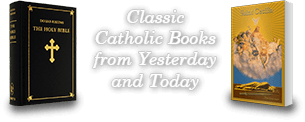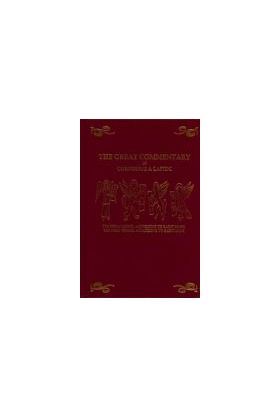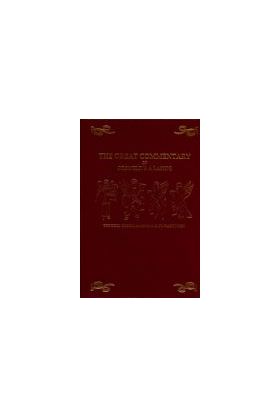Categories
Information
Cornelius a Lapide created a Scripture Commentary so complete and scholarly that it was practically the universal commentary in use by Catholics (often available only in 30 some Latin volumes) for hundreds of years. As part of the mission of Loreto Publications apostolate we have spent a lot of time and money over the last four years to produce a translation and design a beautiful edition of this priceless commentary so long hidden from the eyes of most Catholics. Now is your opportunity to have access to this masterpiece.
Detailed information and free samples are available from the online edition of a Lapide.
Note: If you have already purchased the books, and wish to purchase online access, contact us.
This is the online edition only. If you would like to purchase the hardcopy or a combination hardcopy/online edition, you can do so here
This set boasts the following features:
- Never Fully Translated Before
- First of over 30+ volumes to come
- A percentage of sales goes to further translations of other volumes
- Extensive discussion of Greek & Hebrew word meanings
Forward to a Lapide's Scripture Commentary
The divorce between sanctity and scholarship that has grown ever since the Reformation is perhaps the greatest impediment today to study of the Scriptures or Theology of any kind. For the first fifteen centuries of Christianitys existence, it was presumed that one studied and commented on the Bible as part of ones own personal quest for holiness and salvation. The fathers of the church, those great saints of the first six hundred years, whose commentaries, for the most part have formed the Churchs scriptural exegesis, were just thatgreat saints. So too with the Scholastics of the Middle Ages, such as SS. Anselm, Thomas Aquinas, and Bonaventure, and Bl. Duns Scotus. But from the time of Martin Luther, biblical research has tended to degenerate ever more into either an intellectual exercise or a search for textual weapons with which to belabor ideological opponents. Perhaps one of the last major commentators to bridge the gap between piety and proficiency was the compiler of the four volumes here before you, Cornelius a Lapide (1567-1637).
The facts of his biography are, on the surface, fairly simple. The Catholic Encyclopedia informs us that:
He studied humanities and philosophy at the Jesuit colleges of Maestricht and Cologne, theology first, for half a year, at the University of Douai, and afterwards for four years at Louvain; he entered the Society of Jesus, 11 June, 1592, and, after two years noviciate and another year of theology, was ordained priest 24 December, 1595. After teaching philosophy for half a year, he was made professor of holy Scripture at Louvain in 1596 and next year of Hebrew also. Twenty years later, in 1616, he was called to Rome in the same capacity, where, on the 3rd of November, he assumed the office which he filled with such renown for many years after. The latter years of his life, however, he seems to have devoted exclusively to finishing and correcting his celebrated commentaries. He was a sincerely pious and zealous priest and an exemplary religious. During his professorship at Louvain he liked to spend his holidays preaching and administering the sacraments, especially at the pilgrimage of Scherpenheuvel (Montaigu).
With moving simplicity and truth he portrayed himself in an emotional prayer to the Prophets at the end of his commentary on Daniel: For nearly thirty years I suffer with and for you with gladness the continual martyrdom of religious life, the martyrdom of illness, the martyrdom of study and writing; obtain for me also, I beseech you, to crown all, the fourth martyrdom, of blood. For you I have spent my vital and animal spirits; I will spend my blood too. With his brethren in religion at Rome he enjoyed so high a reputation for sanctity that, when he died, they gave him a separate burial place, in order to be the more certain of finding his bones when eventually, as they hoped, he should receive the honour of beatification.
Illuminating as this account is in terms of bare facts, there is much left unsaid. Douai, where a Lapide spent a crucial half-year, was also the training ground for many of the fearless English Catholic priests who returned to spread the Faith in their unhappy homeland. Without a doubt, he would have met many a young man whose fate and joy it was to be hanged, drawn, and quartered by the minions of Elizabeth at Tyburn Tree. This taste of heroism no doubt affected his decision to join the Society of Jesus, seedbed of so many martyrs at that time, not only in the British Isles but as far afield as Japan.
Of course, the young a Lapide did not have to look so far to find heroes and martyrs for the Faithquite the contrary! The Netherlands into which the young a Lapide was born was torn by religious and military strife. The church at Scherpenheuvel in Flemish Brabant (to the east of Brussels), for example, at whose pilgrimage a Lapide was such a renowned preacher, was very much a product of combat. Originally the site of a cross-shaped tree in whose boughs rested a statue of the Virgin (about which many miracles had clustered), the place had acquired a great reputation for answered prayers. Starting with the Beeldenstorm (Iconoclasm) of 1566, in which Calvinist mobs surged throughout the Netherlands (modern Belgium, Luxembourg, and the Netherlands were in those days united under the Spanish Crown), mobs of pilgrims arrived in Scherpenheuvel seeking, not just healing, but safety from the Protestants. By 1602, the numbers of visitors (and their alms) allowed a small chapel to be built to house the image. Five years later, two very illustrious pilgrims arrived: Archduke Albert of Austria, Governor of the Netherlands, and his wife, the Archduchess Isabella (who was also King Philip II of Spains daughter). They prayed for the defeat of the Protestant forces who were besieging Ostend, and promised that if victory were granted to the Catholic defenders, they would build a new and more beautiful church to house our Ladys statue. The Protestants were in fact defeated and the siege raised; in 1609 the Archducal couple began a new building. By its completion in 1629, the new church was the jewel of baroque architecture we know today (Pius XI declared it a basilica), and the whole town had been reoriented around it.
Having been born the year after the Beeldenstorm, a Lapides entire childhood and youth were dominated by the conflict. When he was five years old, in 1572, the Calvinists executed the martyrs of Gorkum, seventeen priests and religious who refused to renounce transubstantiation and the papal supremacythenceforth, every Flemish child would know of their example. As the war went on (it would come to be called the Eighty Years War) the Calvinists came to dominate the northern part of the Netherlands, and the Catholics and Spanish the southhence the division today between the mostly post-Protestant Dutch (although practicing Catholics now outnumber practicing Protestants in the Netherlands, and prior to the Vatican IIin part because of their history of persecutionthe Dutch Catholics were renowned for their fervor) and the Catholic Flemish, for all that their language remains almost identical.
Louvain, the university where a Lapide became most renowned for his pastoral work, his scholarship, and his piety, was well protected from actual conflict by Spanish and local Catholic troops. But while this haven provided physical security, the religious conflict, in the Netherlands and throughout Northern Europe was never far away. To Louvain came such as the Presbyterian John Ogilivie from Scotland, who was received into the Church by Father a Lapide, followed his mentor into the Society of Jesus, returned to Scotland as a missionary, and after reconciling many of his countrymen to the Faith, was hanged in 1615only to be canonized by Paul VI. Fr. a Lapide played a key role in the life of another saint when, having been transferred to Rome, he administered the last rites to S. John Berchmans.
But for Cornelius a Lapide, his place in the battle lines of the 17th century was neither on the field of combat nor in the missionary field. Instead, he fought the war in two other areas. One, of course, was in himselfthat battle for personal holiness that all of us are called upon to wage, and in which most of us regularly fail. The second, however, was that which lay at the root of the Protestant revolt: interpretation of the Bible.
Martin Luther, John Calvin, and the rest had based their revolt upon the supposed right of private judgmentthe notion that the Holy Ghost will give to each believer the meaning of the often obscure passages of holy Scripture. Of course, this task, heretofore universally accepted to be part of the Churchs mission, had, as noticed, already been extensively dealt with by the Church fathers and doctors. But for the Protestants, all this commentary was simply to be discarded in favor of whatever the Holy Ghost appeared to tell the individual. Practically speaking, however, the Reformers quickly decided that it was what the Holy Ghost told their founders (Luther for the Lutheran, Calvin for the Presbyterians, Puritans, and Reformed) that was to be followed. During the conflictsreligious and politicalthat arose, oceans of ink were spilled publishing a vast array of contradictory books and pamphlets that had one goalattempting to refute the Catholic understanding of Scripture with that of whichever of the Reforming gurus the particular writer favored. It was on this confusing battlefield that Cornelius a Lapide took his stand.
The vast scholarship of the Flemish Jesuit was equaled by his piety and it gives a freshness and a power to his commentaries lacking in those of many other. He adduces both historians and the greatest Church fathers to provide a line by line reading of all the Scriptures save Job and the Psalms. So effective was his work that many converts were made by it, and several Anglican and Lutheran theologians adopted and enjoined its use (obviously, these were of the high church variety). From a Lapides Scriptural studies emerged his views on Marian devotionespecially that of Slavery to Mary. S. Louis Marie de Montfort, the great exponent of this practice, speaks of a Lapides attitude toward it in his True Devotion to MaryCornelius a Lapide, as praiseworthy for his piety as for his profound erudition, having been commissioned by several bishops and theologians to examine this devotion, did so with great thoroughness and deliberation, and praised it in a manner which we might have expected from his well known piety; and many other distinguished persons have followed his example.
Other, later, saints also derived much from our author. S. Gaspar Bertoni, for example, founder of the Stigmatine Fathers and quite a Biblical commentator himself, was heavily influenced by Cornelius a Lapide. S. Anthony Mary Claret was also very fond of his work, and, indeed, the same could be said of many more saints, blesseds, and holy founders.
Unfortunately, the 19th and 20th centuries saw a tragic event which effectively cut off the wisdom of a Lapide from a world ever more in need of it: part of the continuing decay of education in western countries was the gradual abandonment of the study and teaching of Latinto the point that even at Romes Gregorian University, once the great light of the Jesuit Order, and where Cornelius himself had taught, had, until his firing in 2006, only a single Latin instructor, and he was a Carmelite. Clearly, for some, ignorance is indeed strength.
At any rate, what this meant is that the strong meat of a Lapides Commentaries were denied to the vast majority of Catholics and others. In both France and England in the 19th century, one reaction to this was the translation of key liturgical and theological works into the vernacular. Thus, Dom Prosper Gueranger, O.S.B. revealed in French the treasures of the Missal in The Liturgical Year, done into English by Dom Laurence Shepherd; John Mason Neale translated many of the hymns of the Divine Office into English verse; and the Marquess of Bute did the same with the breviary as a whole. As part of this general movement, the Reverend Thomas W. Mossman (1826-1885), Rector of East Torrington and Vicar of West Torrington, Lincolnshire, translated much of Cornelius a Lapides commentaries into English. His translation was the basis for that of the four gospels which you see before you.
At this point, the Catholic reader might fear either that the Reverend Mossman might have left something out, or perhaps mistranslated the text. Well, he did in fact leave out about a quarter of a Lapides worknot, however, for party reasons, but because the material is of a technical nature, dealing with linguistic issues, and translations back and forth between Aramaic, Hebrew, Greek, and Latin; doubtless he felt that these matters would not appeal to the general reader (the fact that the rest would says much about the educated Victorian public). In any case, in the version you have, all of that has been restored. Moreover, his translation was very nearly perfect. All of which having been said, why did he do it, and why should a Catholic employ his work? The answer is at once simple and intriguing: the Reverend Mossman led a double life. He was at once a respected Church of England clergyman, and one of the three duly consecrated bishops in the Order of Corporate Reunion.
Arriving at Oxford in 1845, Mossman became a member of the Oxford Movement, which had been agitating the university and all England since Kebles sermon on National Apostasy in 1833. The year he became an undergraduate, however, John Henry Newman, who had been one of the leaders of the movement from its inception finally decided to join the Catholic Church. Many members of the movement would follow him, but many more remained within the fold of the Church of England. Under the continuing leadership of Newmans one-time collaborator, Edward Pusey, such as these believed in the Movements original goal of re-catholicizing the Church of England. Moreover, they believed in foreign missions and domestic slum work on a grand scale. Thus were the origins of the Anglo-Catholic wing of Anglicanism that has survived until our own day. But within Anglo-Catholicism two separate currents emerged: one held that the point of vestments, adoration of the Blessed Sacrament, veneration of our Lady and the saints, etc., was to give Anglicans everything that Catholics had, without having to submit to the pope; the other believed that reunion with Rome ought to be the goal, as the best means of re-evangelizing England and the English-speaking world.
By the time Mossman graduated in 1849, he had definitely adhered to the latter wing of Anglo-Catholicism. The following year he was ordained to the Anglican priesthood, and after serving as a curate in several spots, he was made Rector-Vicar of the Torringtons. Having unsuccessfully tried on his own to revive religious life in the Church of England with a Brotherhood of the Holy Redeemer, in 1856 he joined the newborn Society of the Holy Cross, a non-residential Anglican order. Then as now, it was one of the pillars of Anglo-Catholicism.
The mid-19th century was truly a boom-time for the Anglo-Catholics. religious orders, devotional societies (Society of Mary, Guild of All Souls, Confraternity of the Blessed Sacrament, Society of King Charles the Martyr) given over to Marian and Eucharistic veneration, and prayer for the deadshunned by the reformersand all manner of works at home and abroad mushroomed. Various elements of the Sarum and Roman rites were revived or adapted, and used to augment the rather sparse liturgy of the Book of Common Prayer. Lights, vestments, and processions revived, and some bishops once again began to wear mitres. But there was opposition as well, and since many of the Protestant forms of worship were mandated by law, a few Anglo-Catholic clerics did jail time for reviving some of these practices, and many more were threatened.
The result was the generation of an enormous body of literature intended to defend the revived practices from every conceivable point of view: scriptural, theological, historical, legal, or whatever came to hand. The men who wrote this stuffmost often graduates of Oxford or Cambridgewere highly educated in a manner almost impossible to conceive of today. Armed with a knowledge of Greek, Latin, and the literatures and histories of those languages (to say nothing of English, French, German, and often others) university graduates were expected to be able to do anything. Some went forth so intellectually armed to govern parts of India and other British colonies. But Mossman put his talents to the service of the church as he conceived her. Among the large number of histories, commentaries, and translations he wrote, the English version of Cornelius a Lapide stands out. It was nothing less than a scriptural defense of the Catholic Church, a shining light in a time of confusion and controversynot unlike those times when a Lapide first set it down.
But just what was that church? So far as Anglo-Catholics (who believed in the validity of Anglican orders), were concerned, the one Catholic Church had three independent branchesthe Roman, the Eastern, and the Anglican (later they would add Old Catholics and some Lutheran bodies). For some Anglo-Catholics, as mentioned, the status quo was fine: the Church of England was simply the Catholic Church in England, no different from the national Churches of France and Spain, save that those were in communion with Rome. Some of such thinkers went so far as to dub the Roman clergy in England the Italian Mission, and to claim that those who converted to Catholicism were abandoning their ancient and ancestral church.
But, as also noticed, others thought that since neither the queen of Great Britain nor the tsar of Russia (the heads of the two leading European national churches during the 19th century) could possibly be considered proper religious leaders, unity with the pope was essential. But rather than convert as individuals, such folk thought it necessary to give the Church of England a makeover, catholicize it, and bring the whole country over to Rome en masse.
There were Catholics of a like mind. In 1857, wealthy Catholic layman, Ambrose Phillipps De Lisle and noted architect Augustus Pugin joined with the papalist Anglo-Catholic cleric and scholar, Frederick G. Lee, the Rector of All Saints, Lambeth to form the Association for the Promotion of the Unity of Christendom. Its members bound themselves to work for the reunion of the Catholic Church, the Orthodox Churches, and the Church of England. For most members of either faith, the goal was the establishment of a sort of Anglican Uniate Rite, united with Rome but preserving a married clergy, vernacular bible, and communion under both species. In 1864, however, the holy see ordered the Catholic members to leave the organization, which they did. Three decades later, Anglican survivors would help found the Catholic League, which still prays for the reunion of Anglicanism with Rome. In all of this activity, however, Mossman remained an interested and sympathetic spectator.
But the holy see was not uninterested in reunion; they wanted to make sure that all aspects of such a move be directed from the Vatican. When Bl. Pius IX restored the hierarchy of bishops to England in 1850, he did not restore the historic sees, as he did in Scotland and the Netherlands later in the century. This was to underline the provisional nature of the Church in England. The pope made it quite clear that if the Anglican bishops wished to return to communion with the holy see, their dioceses would become the units of governance, and they themselves would retain their cathedrals and sees.
But the flurry of Anglo-Catholic activity in England during those years led many, including Pius, to believe that the Church of England was, in fact, in the process of catholicizing itself. One strong problem, however, was the lack of validity of Anglican orders. No less a stalwart than Frederick Lee became convincedin the course of writing a book in defense of the Anglican positionthat the Roman position was correct. Various others, to include Mossman, felt the same way. Eventually, the Order of Corporate Reunion was born, with the precise goal of reuniting the Church of England with Rome through a program of validating Anglican clerics. Due to the literary prominence of Lee and Mossman, who were both members, Rome became convinced of the feasibility of the project. The result was a rather strange ceremony in early 1877.
Conducted in strictest secrecyallegedly aboard a boat off Venice and so out of any diocesan territorythe cardinal archbishop of Milan, the patriarch of Venice, and an Armenian Catholic bishop co-consecrated, using the Ambrosian Rite, three Englishmen as bishops for the Order of Corporate Reunion. These were Mossman, Lee, and John Thomas Seccombe (1835-95), who had been instrumental in the attempt to form a Western Orthodox Church. Upon their return to England in June, the trio issued a pastoral explaining the doctrinal decay of the Anglican Church and the necessity of what they were doing. Given that the work of the order was to remain secret, the three new bishops signed their letter to the English with pseudonyms: Thomas, Pro-Provincial of Canterbury (Mossman); Joseph, Provincial of York (Seccombe); and Laurence, Provincial of Caerleon (Lee). Seccombe quickly lost interest, and drifted out of the picture. Mossman, soon notorious for his validation work, was expelled from the Society of the Holy Cross, and died in 1885, received on his deathbed into the Catholic Church by his old friend, Cardinal Manning. Dr. Lee soldiered on, retiring from his parish in 1899, being received into the Catholic Church in 1901, and dying the following year; before this, he destroyed all his files relating to the Order, so that little can be known for sure. Still, today, many Old Catholic groups claim descent from it.
Although the O.C.R. did not achieve its goal, it does show that Mossman was willing to make sacrifices for the tenets of the Catholic Faith, in which he believed completelyto include the infallibility of the pope. As with a Lapide, he combined action in a time of controversy with prayer and study. In this way, he certainly became a worthy translator for the greatest single work of biblical exegesis in recent centuries.
Which brings us at last to ourselves. As noted, this edition includes the quarter-portion of technical stuff left out of Mossmans original. Here and there his translation needed a bit of touching up. All-in-all, this is an edition that will go far to open up the riches of a Lapide to the general public. Not a moment too soon, either. As with he himself and Mossman, we live in a world of controversy and strife. Knowledge of the four gospels is as powerful a weapon against falsehood and error in the 21st century as it was in the 17th and 19th centuries. Let us all be grateful we now need not be unarmed.
Charles A. Coulombe
27 July 2007
Saint Anne
No posts found










